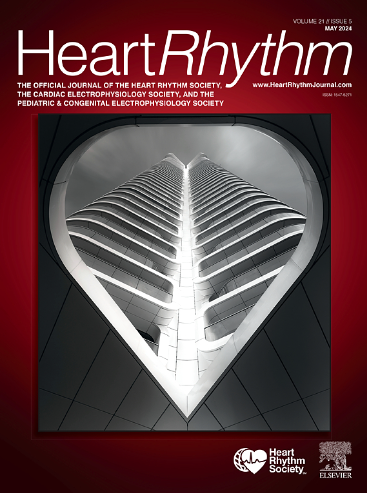Chronic angiotensin-converting enzyme inhibition attenuates frailty and protects against atrial fibrillation in aging mice
IF 5.6
2区 医学
Q1 CARDIAC & CARDIOVASCULAR SYSTEMS
引用次数: 0
Abstract
Background
Aging is a major risk factor for atrial fibrillation (AF); however, not all individuals age at the same rate. Frailty, which is a measure of susceptibility to adverse health outcomes, can be quantified with a frailty index (FI).
Objective
This study aimed to determine the effects of angiotensin-converting enzyme (ACE) inhibition on AF and atrial remodeling in aging and frail mice.
Methods
Aging mice were treated with the ACE inhibitor enalapril for 6 months beginning at 16.5 months of age and frailty was quantified. AF susceptibility and atrial structure and function were assessed by intracardiac electrophysiology in anesthetized mice, high-resolution optical mapping in intact atrial preparations, patch clamping in isolated atrial myocytes, and histology and molecular biology in atrial tissues.
Results
Enalapril attenuated frailty in aging mice with larger effects in females. AF susceptibility was increased in aging mice but attenuated by enalapril. AF susceptibility and duration also increased as a function of FI score. P-wave duration was increased and atrial conduction velocity was reduced in aging mice and improved after enalapril treatment. Furthermore, P-wave duration and atrial conduction velocity were strongly correlated with FI score. Atrial action potential upstroke velocity (Vmax) and Na+ current (INa) were reduced whereas atrial fibrosis was increased in aging mice. Action potential Vmax, INa, and fibrosis were improved by enalapril and also correlated with FI scores.
Conclusion
ACE inhibition with enalapril attenuates frailty and reduces AF susceptibility in aging mice by preventing atrial electrical and structural remodeling.
慢性血管紧张素转换酶抑制可减轻衰老小鼠的虚弱程度并防止心房颤动。
背景:衰老是心房颤动(房颤)的主要风险因素;然而,并非所有人的衰老速度都相同。虚弱是对不良健康后果易感性的一种衡量标准,可通过虚弱指数(FI)进行量化:目的:确定血管紧张素转换酶(ACE)抑制剂对衰老和虚弱小鼠房颤和心房重塑的影响:方法:从 16.5 月龄开始,用血管紧张素转换酶(ACE)抑制剂依那普利对衰老小鼠进行为期 6 个月的治疗,并对衰弱程度进行量化。使用麻醉小鼠的心内电生理学、完整心房制备的高分辨率光学绘图、离体心房肌细胞的膜片钳以及心房组织的组织学和分子生物学方法对房颤易感性以及心房结构和功能进行了评估:结果:依那普利减轻了衰老小鼠的虚弱程度,对雌性小鼠的影响更大。衰老小鼠房颤易感性增加,但依那普利可减轻房颤易感性。房颤易感性和持续时间也随 FI 评分的增加而增加。老龄化小鼠的 P 波持续时间增加,心房传导速度降低,而依那普利治疗后则有所改善。此外,P 波持续时间和心房传导速度与 FI 评分密切相关。衰老小鼠的心房动作电位上冲速度(Vmax)和Na+电流(INa)降低,而心房纤维化增加。依那普利可改善动作电位Vmax、INa和纤维化,并与FI评分相关:结论:用依那普利抑制 ACE 可以减轻衰弱,并通过减轻心房电和结构重塑来降低老龄小鼠房颤的易感性。
本文章由计算机程序翻译,如有差异,请以英文原文为准。
求助全文
约1分钟内获得全文
求助全文
来源期刊

Heart rhythm
医学-心血管系统
CiteScore
10.50
自引率
5.50%
发文量
1465
审稿时长
24 days
期刊介绍:
HeartRhythm, the official Journal of the Heart Rhythm Society and the Cardiac Electrophysiology Society, is a unique journal for fundamental discovery and clinical applicability.
HeartRhythm integrates the entire cardiac electrophysiology (EP) community from basic and clinical academic researchers, private practitioners, engineers, allied professionals, industry, and trainees, all of whom are vital and interdependent members of our EP community.
The Heart Rhythm Society is the international leader in science, education, and advocacy for cardiac arrhythmia professionals and patients, and the primary information resource on heart rhythm disorders. Its mission is to improve the care of patients by promoting research, education, and optimal health care policies and standards.
 求助内容:
求助内容: 应助结果提醒方式:
应助结果提醒方式:


